USER GUIDE

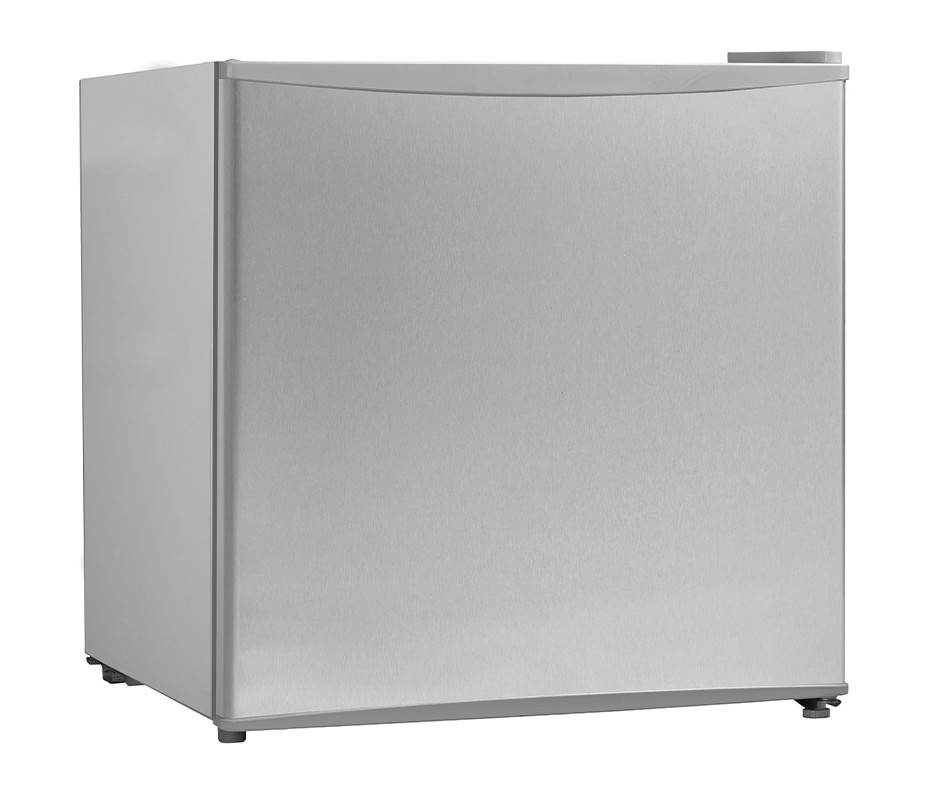
46L BAR FRIDGE(KAM46LBRSFA, KA46WCBRFGA, KAM46LBRSFB)THIS USER GUIDE COVERS THE FOLLOWING MODELSKogan 46L Bar Fridge – Stainless Steel (KAM46LBRSFA)Kogan 46L Bar Fridge – White (KA46WCBRFGA)Kogan 46L Bar Fridge – Black (KAM46LBRSFB)
SAFETY AND WARNINGS
Thank you for buying this Kogan product. Please read all safety instructions before using your bar fridge.![]() WARNING: RISK OF FIRE / FLAMMABLE MATERIALS
WARNING: RISK OF FIRE / FLAMMABLE MATERIALS
- Read this manual thoroughly before first use, even if you are familiar with this type of product. The safety precautions enclosed herein reduce the risk of fire, electric shock and injury when correctly adhered to.
- Make sure you understand all instructions and warnings.
- This appliance is only intended for use within a domestic environment only.
- Children should be supervised to ensure that they do not play with the appliance.
- If the power supply cord is damaged, it must be replaced by a Kogan.com technician or similarly qualified person in order to avoid a hazard.
- Do not store explosive substances such as aerosol cans with flammable propellants inside.
- Unplug the appliance after use and before carrying out any user maintenance.
- Keep all ventilation openings clear of obstructions.
- Do not use mechanical devices or other means to accelerate the defrosting process.
- Do not use extension cords.
- The refrigerant and cyclopentane foaming material used in this appliance is flammable.
- When unplugging the appliance from the power outlet, grasp the plug and pull on it. Do not pull on the cord.
- Please use a dedicated power socket for this appliance. Do not share the outlet with other appliances via a power board or double adapter.
- Do not disassemble or attempt to repair the refrigerator by yourself. Doing so will void the warranty. Kogan.com is not liable for an appliance that has been tampered with.
- The gap between the refrigerator door and the cabinet is small. Do not put your hands in this area to avoid having your fingers pinched.
- Do not touch or move items from the cooler compartment with wet hands.
- Do not allow animals or pets to climb into or onto the refrigerator.
- Do not place heavy objects on top of the refrigerator.
- Unplug the unit from the power outlet in the event of a power failure or when cleaning. Avoid plugging the unit back within 5 minutes after unplugging to avoid damage to the compressor.
- The refrigerator should be used only for the storage of household foods and drinks. It is not designed for storage of blood, drugs or other biological products.
- Do not store beer, beverages or other fluids contained in bottles or enclosed containers in the cooler compartment of the refrigerator, as the bottles may crack due to the freezing process.
- When the refrigerator is being disposed of, the doors should be removed and the power cord should be cut.
Risk of Fire:
- If the refrigerant circuit should become damaged. Avoid open flames and sources of ignition. Disconnect the appliance from the mains power. Thoroughly ventilate the room in which the appliance is situated for several minutes.
Disposing:
- Old appliances should not simply be disposed of with normal household waste, but should be delivered to a collection and recycling centre for electric and electronic equipment. A symbol shown on the product, the instruction manual or the packaging shows that it is suitable for recycling.
- Materials used inside the appliance are recyclable and are labelled with information concerning this. By recycling materials or other parts from used devices you are making a significant contribution to the protection of our environment.
- Information on appropriate disposal centres for used devices can be provided by your local authority
PRODUCT OVERVIEW
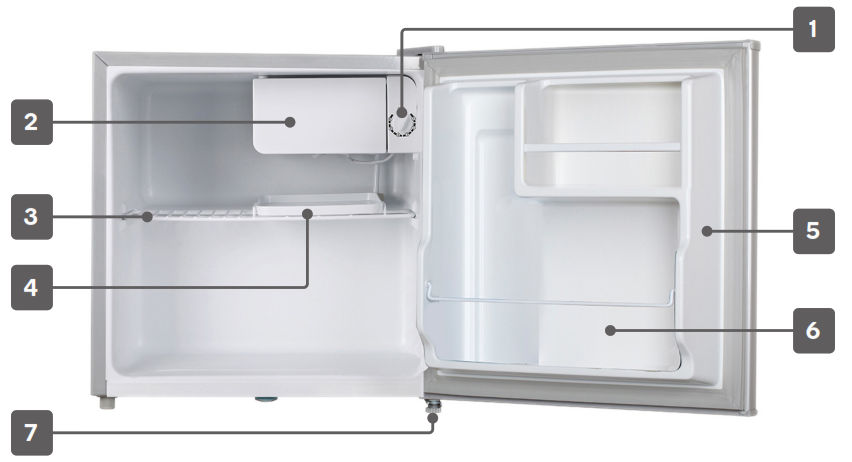
- Thermostat
- Cooler compartment
- Steel wire shelf
- Drain tray
- Bar fridge door
- Bottle rack
- Adjustable foot
INSTALLATION
SELECTING A SUITABLE LOCATIONWhen selecting a position for your unit, ensure the floor is flat and firm, and the room is well ventilated. Avoid placing your unit near a heat source (ie, oven, radiator, or hot water system). Avoid direct sunlight as it may increase electrical consumption. Extreme cold temperatures may also cause the unit to not perform correctly. This unit is not designed for use in a garage or outdoors. Do not drape the unit with any covering.When installing the unit, ensure that 15cm of free space is allowed to the left, right and rear of the unit, and 20cm at the top. This will allow cold air to circulate around the unit and improve the efficiency of the cooling process.
1a. Door space requirementsThe unit’s door must be able to open fully as pictured (1a).
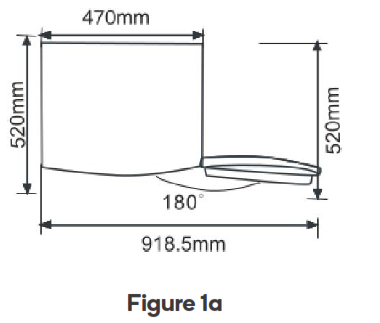
1b. Levelling the unitTo level the unit, adjust the two feet at the front of the unit – turning clockwise to extend and counter-clockwise to reduce (1b). If the unit is not level, the door and magnetic seal alignments will not be covered properly, leading to inefficient freezing performance. Ensure that the feet all touch the ground before use.
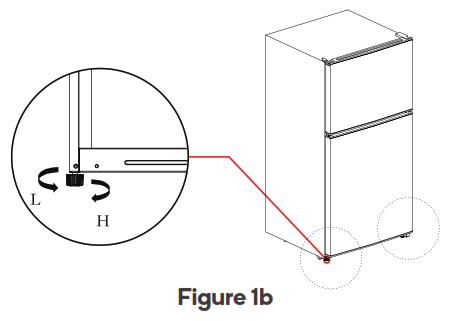
2. Reversing the door swingTOOLS REQUIREDPhillips head screwdriver, flat-blade screwdriver, and hexagonalspanner.

a. Remove the plastic covering from the top door hinge and unscrew the two screws from the bottom bracket. Remove the foot from the opposite side.b. Place the pieces to one side for now.

c. Slide the door down about 15cm and off the top hinge pin and then lift it away from the fridge.d. Remove the two screws from the top bracket and replace them on the other side. You will need to remove the plastic caps from the other side first.
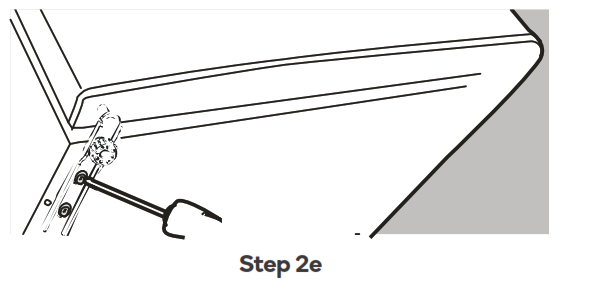
e. Slide the door back onto the top hinge, making sure it is facing the right way up. Screw the bottom hinge into place on the new side. Replace the other foot on the other side and then replace the plastic covering by clicking it back into place on the door hinge.
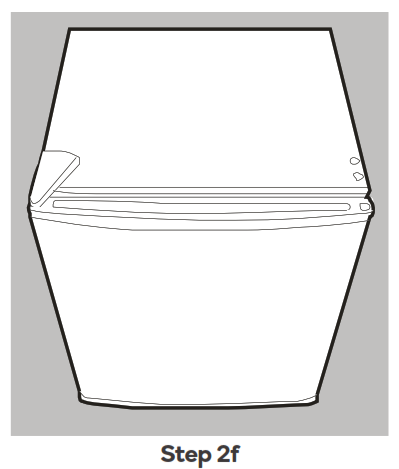
f. Check that the door is aligned horizontally and vertically and that the seals are closed on all sides before finally tightening the bottom hinge.
FIRST TIME USE
POWER SOURCE AND GROUNDINGIt’s recommended to use the vertical fridge on its own dedicated power outlet for both convenience and safety. The power outlet must be grounded.Important! If the supply cord is damaged, it must be replaced by Kogan.com or an authorized service agent on Kogan.com’s behalf. Cease use and ensure the appliance is completely disconnected from the power supply.
Cleaning before useWipe the inside of the unit with a weak solution of bicarbonate soda, then rinse with warm water using a wrung-out cloth or sponge. Wash the shelves and drawers in warm soapy water and dry completely before replacing in the unit. Clean the exterior of the unit with a damp cloth. Further cleaning instructions can be found on page 9.
Before using your unit
- Before initial start, keep the refrigerator still for half an hour before connecting it to power supply.
- Do not use when the power cord is damaged or the plug is worn.
- Do not alter the power cord under any circumstances, so as to ensure safe use.
- Do not put flammable, explosive, volatile and highly corrosive items in the refrigerator to prevent damages to the product or fire accidents.
- Do not place flammable items near the refrigerator to avoid fires.
- This product is a household refrigerator and is only suitable for domestic use.
- According to national standards, household refrigerators shall not be used for other purposes, such as storage of blood, drugs or biological products.
- Important! Before plugging in your fridge, you must check that you have a power outlet which is compatible with the plug supplied on the appliance lead.
Operation
- Before putting any fresh or frozen foods into the fridge, the fridge should be left to run for 2-3 hours. If the temperature is especially high during summer, wait up to 4 hours.
- All frozen food products that you purchase should be placed in the cooler compartment as soon as possible to avoid the frozen food from defrosting.
- Storage recommendation printed on the packaging of frozen food by the manufacturers should always be followed.
- Ensure that the drawer doesn’t damage the refrigerant circuit.
Noise from your fridge
- You may notice that your fridge makes some unusual noises. This is completely normal for refrigerators and freezers, and the noises are caused by the circulation of the refrigerant liquid within the cooling system.
Tips for keeping food within the fridge
- Cooked meats & fish should always be stored on a shelf above raw meat/fish to avoid a bacterial transfer. Keep raw meat/fish in a container that is large enough to collect juices and cover properly, placing the container on to the lowest shelf.
- Leave space around your food to allow air to circulate inside the unit.
- Ensure all parts of the appliance are kept cool.
- To prevent transfer of flavours and drying out, pack or cover the food separately. Fruit and vegetables do not need to be wrapped.
- Always let pre-cooked food cool down before you place it into the fridge. This will help to maintain the internal temperature of the fridge.
- To prevent cold air from escaping the fridge, try to limit the number of times you open the door.
CLEANING AND MAINTENANCE
WARNING! To avoid an electric shock, always unplug your fridge before cleaning.Cleaning the inner cabinet
- Caution: Before using any cleaning products, please read and follow the manufacturer’s instructions and warnings to avoid any damage to your fridge or personal injury.
- Upon installation of your new appliance, it is recommended that it be cleaned thoroughly.
- Wash the inside with a damp warm cloth containing a water and baking soda solution.
- The solution should be about 2 tablespoons of baking soda to 2L of water.
- Wash the storage basket with a mild detergent solution.
- Be sure to keep the door seal clean to keep the unit running efficiently.
- The outside of the fridge should be cleaned with mild detergent and warm water.
- Dry the interior and exterior with a soft cloth.
- The condenser coils should be carefully vacuumed when they are dusty or dirty.
- It is recommended that the unit be cleaned each time it is defrosted to help keep the unit odour free and running efficiently.
- Clean your door gasket seals every 3 months using the same warm water solution described above.Cleaning tips
- Condensation may appear on the outside of the unit. This may be due to a change in room temperature. Wipe of any moisture residue. If the problem continues, please contact a qualified technician for assistance.Care When Handling / Moving Your Unit
- Hold the unit around its sides or base when moving it. Under no circumstances should it be lifted by holding the edges of the top surface.
CLEANING AND MAINTENANCE
Servicing
- The unit should be serviced by an authorised engineer and only genuine spare parts should be used. Under no circumstances should you attempt to repair the unit yourself. Repairs carried out by inexperienced persons may cause injury or serious malfunction. Contact Kogan.com
Defrosting
- Unplug the power cord.
- Remove food and store it properly to avoid food spoilage.
- Clear the drainpipe.
- Place down trays to catch the water as the frost melts.
- You can let the unit defrost using the natural temperature of the room. If there is a large amount of ice, an appropriate amount of hot water can be used to speed up the melting process.
- Once defrosted, close the fridge and plug the unit back into a power outlet.
- After a few hours, you are safe to return the food to the fridge.
Switching Off for Long Periods of Time
- When the unit is not in use for a long period of time, disconnect it from the mains supply, empty all food and clean the appliance, leaving the door ajar to prevent unpleasant smells.
Warm tips
- The refrigerator enclosure may emit heat during operation especially in summer, this is caused by the radiation of the condenser, and it is a normal phenomenon.
- Condensation phenomenon will be detected on the exterior surface and door seals of the refrigerator when the ambient humidity is large. This is a normal phenomenon, and the condensation can be wiped away with a dry towel.
- Buzz will be generated by running the compressor especially when starting up or shutting down.
Tips for energy saving
- This appliance should be located in the coolest area of the room, away from heat sources and heating ducts, as well as away from directsunlight.
- Let hot foods cool to room temperature before placing them in the refrigerator. Overloading the fridge forces the compressor to run longer. Foods that freeze too slowly may lose quality or spoil.
- Be sure to wrap foods properly and wipe containers dry before placing them in the fridge. It will cut down on frost build-up.
- The storage bin should not be lined with aluminium foil, wax paper or paper towelling. These liners will interfere with the cold air circulation, making the appliance less efficient.
- Organise and label your food to reduce door openings and extended searches. Remove as many items as needed at one time and then close the door as soon as possible.
Disposal
- This marking indicates that this appliance should not be disposed of with other household wastes. To prevent possible harm to the environment or human health from uncontrolled waste disposal, recycle it responsibly to promote the sustainable reuse of material resources.
- Old units still have some residual value. An environmentally friendly method of disposal will ensure that valuable raw materials can be recovered and used again.
- The refrigerant used in your unit and insulation materials requires special disposal procedures. Ensure that none of the pipes on the back of the unit are damaged prior to disposal.
- Up to date information concerning options of disposing of your old unit and packaging from the new one can be obtained from your local council office.
- When disposing of an old unit break of any old locks or latches and remove the door as a safeguard.
BASIC TROUBLESHOOTING
Fridge isn’t operating
- Check that the fridge is plugged in and connected to power.
- Check whether voltage is too low.
- Check that a fuse hasn’t blown or circuit tripped.
Fridge is making strange odour
- Odorous foods should be closely wrapped and sealed in containers.
- Ensure that the interior is clean. Refer to cleaning instructions. Fridge compressor is continuously running
- It is normal for the fridge compressor to operate for longer periods of time when the ambient temperature is higher (ie. Summer).
- Do not put too much food in the fridge at one time.
- Do not put warm/hot foods into the fridge.
- Try to minimise the frequency of the door opening.
Door seals aren’t tight
- Remove any foreign matter or liquids on the seals.
The fridge door doesn’t close properly
- Ensure that food isn’t preventing the door from closing.
- Ensure that the fridge is completely level and feet adjusted to touch the floor.
- Ensure the fridge door gaskets/seals are clean.
Water pan overflows
- Doors not closed properly, resulting increased defrosting.
- Too much food within the fridge, or stored food contains too much water, resulting in heavy defrosting.
The fridge is making loud noises
- It’s normal for the fridge to make noises when refrigerant coolant is being circulated.
- Check that the fridge is correctly levelled.
Fridge body is hot
- Heat dissipation of the built-in condenser into the body is normal. Surface condensation
- Condensation on the exterior surface and door seals is normal when the ambient humidity is too high. It can be wiped away with a clean towel.
For our full FAQ and troubleshooting guide, head online to help.kogan.com
SPECIFICATIONS
CapacityVolume – Total: 46L Net: 45L
DimensionsDimensions – (W x D x H): 475 x 444 x 495mmWeight – 14.15kgPerformanceTemperature Control Range – 0.5 to 6degC
PowerEnergy Consumption – 221kWh per yearEnergy Rating – 1.5 Star
Note:
- Design and specifications are subject to change without notice.
- Weight and dimension shown are approximate.
Need more information?We hope that this user guide has given you the assistance needed for a simple set-up. For the most up-to-date guide for your product, as well as any additional assistance you may require, head online at help.kogan.com
[xyz-ips snippet=”download-snippet”]

